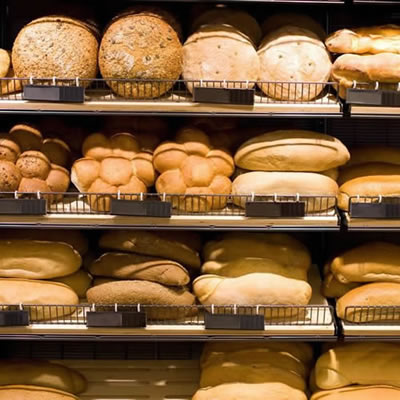
Shelf Life Extension
What is Shelf Life Extension?
Shelf life extension is an effort to make food safe for long periods, still keeping its original quality. Baked products beyond their shelf life can become:
- Stale, firm and dry
- Less resilient
- Not as flavorful
- Unsafe due to microbial growth
Advances in bakery processing technologies and ingredients innovation have led to significant shelf-life extension. For example, breads and buns that traditionally lasted 6 or 10 days, now remain soft, springy and mold-free up to 3 weeks.
How does it work?
Two main factors influence the shelf life of bakery products:
- Microbial spoilage: Product contamination with air-borne mold spores starts immediately after leaving the oven. As time passes, microbial growth continues to increase. Eventually, green spots form on the crust.
- Staling and moisture loss from product: Bread staling can affect both bread crust and crumb. Crust staling is generally caused by moisture transfer or migration from the crumb to crust. The result is a soft, leathery texture. On the other hand, crumb staling happens when hydrated starch reverts to the crystalline form.
Application
To extend the shelf life of products, different ingredients and processes can be used. Strategies depend on the end product, and if it is a clean label or not. Here are some solutions to slow both mold and staling.
Preventing mold spoilage:1,2,3,4
- Mold inhibitors: can be clean label mold inhibitors or artificial preservatives.
- pH and acidity: lowering the pH of the final product using acidulates or long dough fermentations, such as sourdough and preferments.
- Cleaning and sanitation: implementing good cleaning and sanitizing practices in critical product-contact surfaces. For example, pay attention to the mixer, divider, conveyors and cooler. Mold spores can not survive the baking process, so sanitation is key for controlling mold growth or product recontamination after baking.
- Implementation of HACCP principles: a HACCP plan is a systematic approach to food safety management that identifies and evaluates food safety hazards.
- Water content: controlling water activity and moisture content in baked products can be done with optimum baking and cooling conditions.
- Packaging: using adequate packaging method and materials. For example, modified atmosphere packaging (MAP) reduces mold growth and increases shelf life.
Slowing down staling rate and moisture loss4,5,6
- Emulsifiers as crumb softeners: although they do not produce softer fresh bread, they do slow the rate of firming over time. Some examples are lecithin, mono- and di-glycerides, amphiphilic proteins, alpha-cyclodextrin, DATEM, SSL and CSL.
- Hydrocolloids: can slow crumb moisture loss. When choosing hydrocolloids, keep in mind their capacity to make liquids dense. Also, their water holding capacity, hydration rate, and the effect of temperature on hydration.
- Enzymes: alpha-amylase, xylanase, and lipase have significant anti-staling effects. Hydrolysis of starch by alpha-amylases release dextrins and other oligosaccharides.
- Long fermentations: using dough systems that require long bulk fermentation before mixing. For example, sourdough or yeast preferments like sponges and poolish.
- Freezing: freezing temperatures pretty much stop all chemical reactions and molecular motion. So, this prevents starch from recrystallizing after baking.
FDA Regulation
A principle of U.S. food law is that food must be wholesome and fit for consumption. A product that is dangerous to consumers would be subject to potential action by the FDA. It could be removed from commerce, regardless of any date printed on a label.
In an effort to reduce food waste, the U.S. Department of Agriculture’s (USDA) Food Safety and Inspection Service (FSIS) have revised current guidelines for product dating on labels. FSIS is changing recommending using “Best if Used By” because research shows that this phrase is easily understood by consumers as an indicator of quality, rather than safety.7
References
- Albers-Nelson, R. “Clean Label Mold Inhibitors for Baking”. Oklahoma State University Cooperative Extension FAPC-173, 2010.
- Tucker, G.S. Food Preservation and Biodeterioration, 2nd Edition, by John Wiley & Sons, Ltd, 2016, pp. 1–35;193–204.
- Smith, J. Food Additives Data Book, 2nd Edition, Blackwell Publishing Ltd., 2011, pp. 2–916.
- Igoe, R.S. Dictionary of Food Ingredients, 5th Edition, by Springer Science+Business Media, LLC, 2011, pp. 3–244.
- Cauvain, S.P. “Bread Spoilage and Staling.” Technology of Breadmaking, 3rd Edition, Springer International Publishing Switzerland, 2015, pp. 287–299.
- Rayas-Duarte, P., and Mulvaney, S. “Bread Staling.” Breadmaking: Improving Quality, 2nd Edition, Woodhead Publishing Limited, 2012, pp. 580–594.
- “USDA Revises Guidance on Date Labeling to Reduce Food Waste” United States Department of Agriculture Food Safety and Inspection Service. 14 Dec. 2016. https://www.fsis.usda.gov/wps/portal/fsis/newsroom/news-releases-statements-transcripts/news-release-archives-by-year/archive/2016/nr-121416-01

